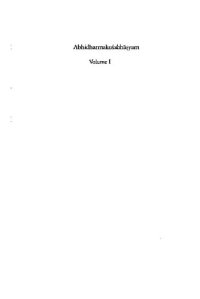
Ebook: Abhidharmakośabhāṣyam of Vasubandhu Vol. 1
- Genre: Religion // Buddhism
- Tags: buddhism philosophy india abhidharma vasubandhu buddhist philosophy
- Year: 1988
- Publisher: Asian Humanities Press
- City: Berkeley
- Language: English
- pdf
Volume 1 of Leo M. Pruden's English translation (1988) of La Vallée Poussin's French translation (1923–1931) of Xuanzang's Chinese translation (7th century) of Vasubandhu's Abhidharmakośa-Bhāṣya.
Vasubandhu's "Abhidharmakosa-Bhasya" (ca. 380-390), besides its culminating achievement in streamlining the overall structure of the exposition of the preceding "Abhidharma" manuals, is unmatched by any of the preceding manuals in respect of its comprehensiveness - incorporating all important Vaibhasika doctrines since the time of the Abhidharma-mahavibhasa - of its excellent skill in definition and elucidation, and of its ability to clarify the difficult points involved in doctrinal disputations. Added to these qualities is its great value as a brilliant critique and insightful re-evaluation of all the fundamental Sarvastivada doctrines developed up to its time. Since its appearance, it has been used as a standard textbook for the understanding of not only the Abhidharma doctrines but all the fundamental Buddhist doctrines in general. Translated into Chinese by Paramartha in 563 A.D. and by Hsuan-tsang in 651-654 A.D., Hsuan-tsang's disciple P'u-Kuang tells us that in India the "Abhidharmakosa-Bhasya" was hailed as the "Book of Intelligence". In China, Japan and the Far-east, too, the Kosa has generally been highly treasured as a textbook of fundamental importance for Buddhist studies. Vasubandhu's brilliant critique of the doctrines of the Vaibhasika was answered by the equally brilliant Samghabhadra - a contemporary staunch defender and expounder of the doctrines of the Vaibhasikas - in his masterwork, the "Abhidharmanyayanusara", now extent only in Hsuan-tsang's translation (653-654 A.D.). The Sanskrit text, considered for a long time to be irremediably lost, was discovered by Rahula Samkrtyayana in 1935 in the Tibetan monastery of Ngor and was published by P. Pradhan in 1967 (1st edition).
Vasubandhu's "Abhidharmakosa-Bhasya" (ca. 380-390), besides its culminating achievement in streamlining the overall structure of the exposition of the preceding "Abhidharma" manuals, is unmatched by any of the preceding manuals in respect of its comprehensiveness - incorporating all important Vaibhasika doctrines since the time of the Abhidharma-mahavibhasa - of its excellent skill in definition and elucidation, and of its ability to clarify the difficult points involved in doctrinal disputations. Added to these qualities is its great value as a brilliant critique and insightful re-evaluation of all the fundamental Sarvastivada doctrines developed up to its time. Since its appearance, it has been used as a standard textbook for the understanding of not only the Abhidharma doctrines but all the fundamental Buddhist doctrines in general. Translated into Chinese by Paramartha in 563 A.D. and by Hsuan-tsang in 651-654 A.D., Hsuan-tsang's disciple P'u-Kuang tells us that in India the "Abhidharmakosa-Bhasya" was hailed as the "Book of Intelligence". In China, Japan and the Far-east, too, the Kosa has generally been highly treasured as a textbook of fundamental importance for Buddhist studies. Vasubandhu's brilliant critique of the doctrines of the Vaibhasika was answered by the equally brilliant Samghabhadra - a contemporary staunch defender and expounder of the doctrines of the Vaibhasikas - in his masterwork, the "Abhidharmanyayanusara", now extent only in Hsuan-tsang's translation (653-654 A.D.). The Sanskrit text, considered for a long time to be irremediably lost, was discovered by Rahula Samkrtyayana in 1935 in the Tibetan monastery of Ngor and was published by P. Pradhan in 1967 (1st edition).
Download the book Abhidharmakośabhāṣyam of Vasubandhu Vol. 1 for free or read online
Continue reading on any device:

Last viewed books
Related books
{related-news}
Comments (0)